牛津译林版(2019)高中英语选修第一册 Unit 1 Food matters Welcome to the unit Reading 课件(37张)
文档属性
| 名称 | 牛津译林版(2019)高中英语选修第一册 Unit 1 Food matters Welcome to the unit Reading 课件(37张) | 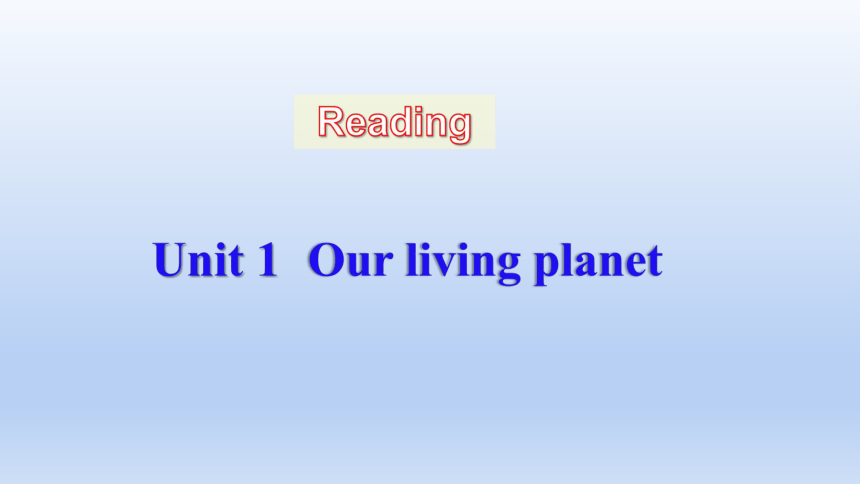 | |
| 格式 | pptx | ||
| 文件大小 | 5.1MB | ||
| 资源类型 | 教案 | ||
| 版本资源 | 牛津译林版(2019) | ||
| 科目 | 英语 | ||
| 更新时间 | 2023-02-25 12:47:44 | ||
图片预览


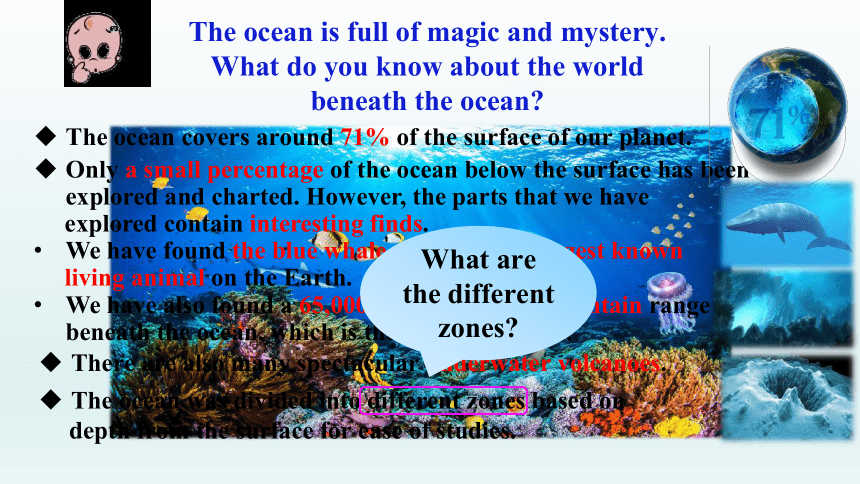
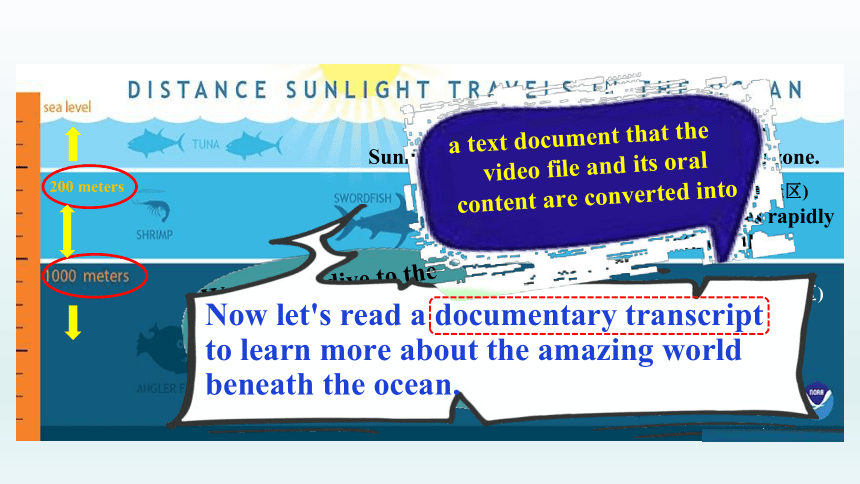

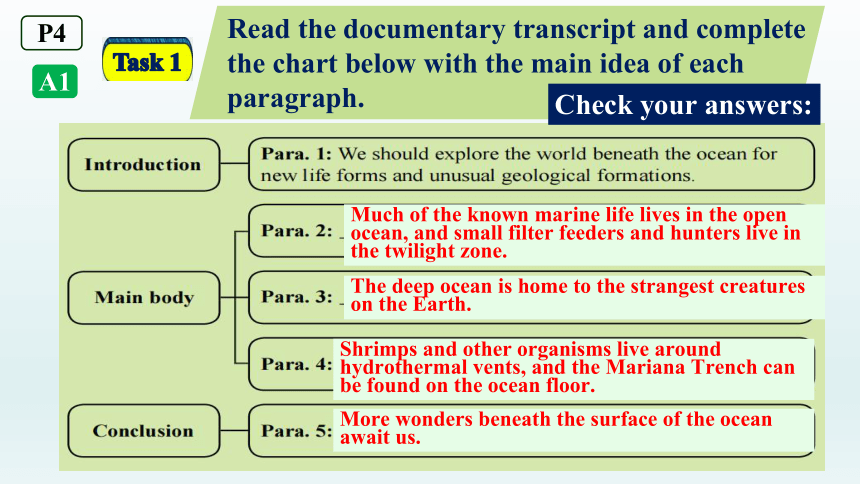
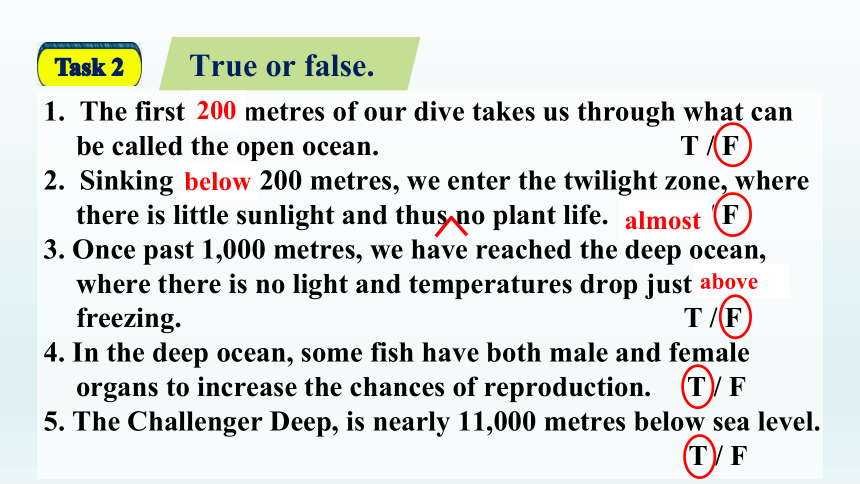
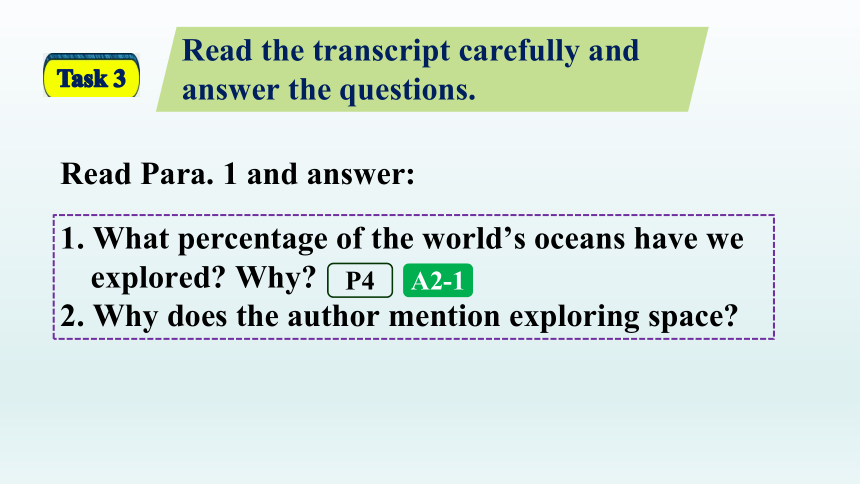
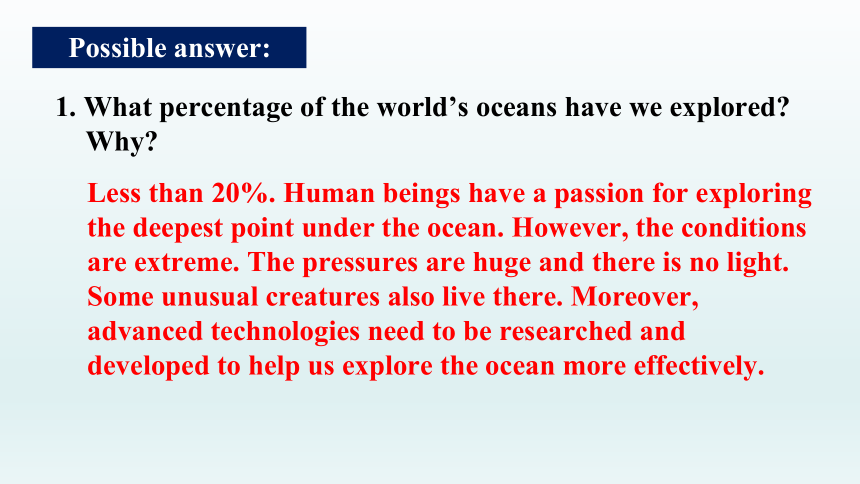
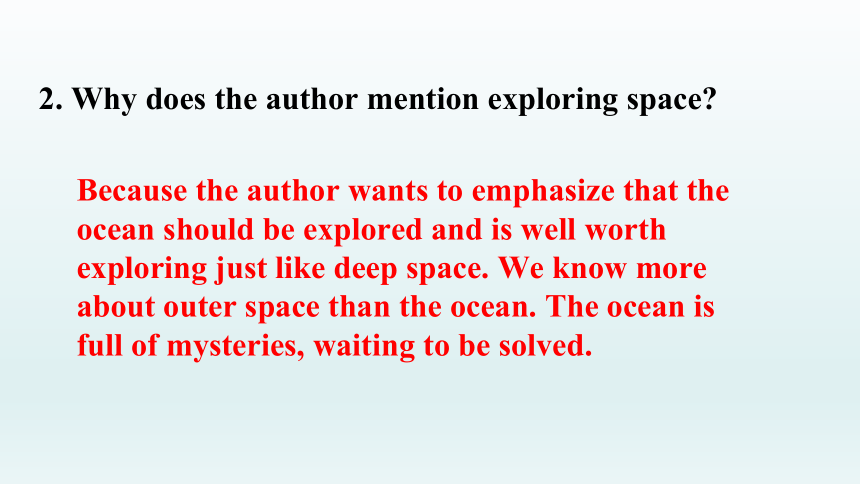
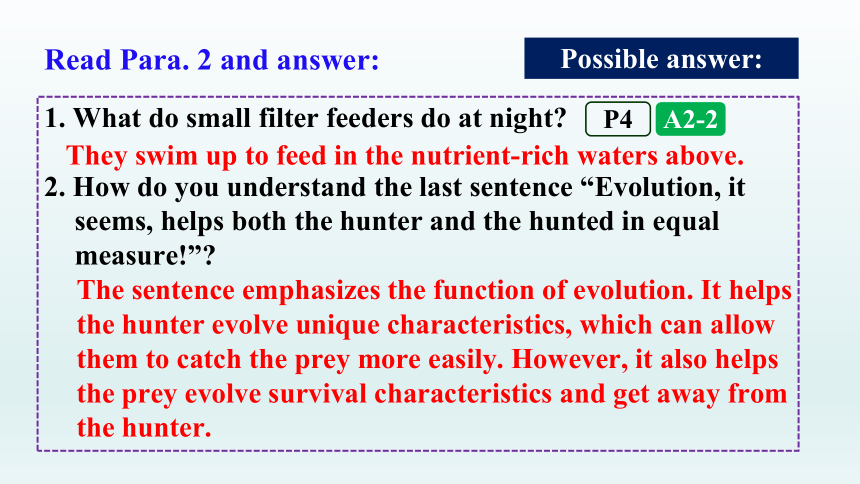
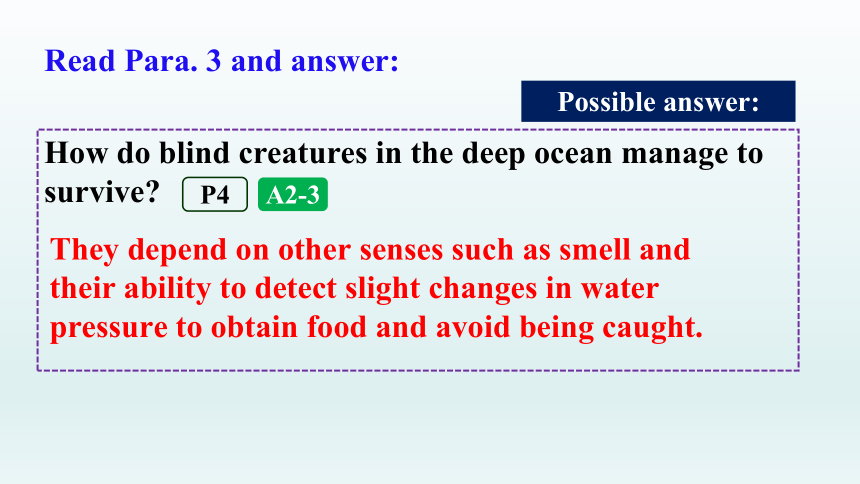
文档简介
(共37张PPT)
Unit 1
Our living planet
Reading
The ocean is full of magic and mystery.
What do you know about the world
beneath the ocean
The ocean covers around 71% of the surface of our planet.
Only a small percentage of the ocean below the surface has been explored and charted. However, the parts that we have
explored contain interesting finds.
We have found the blue whale, which is the largest known
living animal on the Earth.
We have also found a 65,000-kilometre-long mountain range beneath the ocean, which is the world’s longest.
There are also many spectacular underwater volcanoes.
The ocean was divided into different zones based on depth from the surface for ease of studies.
What are the different zones
200 meters
The open ocean/Sunlight zone (透光区)
Sunlight rarely penetrates(穿透) beyond this zone.
Twilight zone(暮光区)
Sunlight decreases rapidly with depth.
The deep ocean(深海区)
Sunlight does not penetrate at all.
Would you dive to the ocean bottom if you had the chance Why or why not
Now let's read a documentary transcript
to learn more about the amazing world beneath the ocean.
a text document that the video file and its oral content are converted into
Read and finish the tasks as quickly as possible.
Task 1
Read the documentary transcript and complete the chart below with the main idea of each paragraph.
Much of the known marine life lives in the open ocean, and small filter feeders and hunters live in the twilight zone.
The deep ocean is home to the strangest creatures on the Earth.
Shrimps and other organisms live around hydrothermal vents, and the Mariana Trench can be found on the ocean floor.
More wonders beneath the surface of the ocean await us.
Check your answers:
P4
A1
Task 2
True or false.
1. The first 100 metres of our dive takes us through what can be called the open ocean. T / F
2. Sinking above 200 metres, we enter the twilight zone, where there is little sunlight and thus no plant life. T / F
3. Once past 1,000 metres, we have reached the deep ocean, where there is no light and temperatures drop just below freezing. T / F
4. In the deep ocean, some fish have both male and female organs to increase the chances of reproduction. T / F
5. The Challenger Deep, is nearly 11,000 metres below sea level.
T / F
200
below
above
almost
Task 3
Read the transcript carefully and answer the questions.
Read Para. 1 and answer:
1. What percentage of the world’s oceans have we explored Why
2. Why does the author mention exploring space
P4
A2-1
1. What percentage of the world’s oceans have we explored Why
Less than 20%. Human beings have a passion for exploring the deepest point under the ocean. However, the conditions are extreme. The pressures are huge and there is no light.
Some unusual creatures also live there. Moreover, advanced technologies need to be researched and developed to help us explore the ocean more effectively.
Possible answer:
2. Why does the author mention exploring space
Because the author wants to emphasize that the ocean should be explored and is well worth exploring just like deep space. We know more about outer space than the ocean. The ocean is full of mysteries, waiting to be solved.
Read Para. 2 and answer:
1. What do small filter feeders do at night
2. How do you understand the last sentence “Evolution, it seems, helps both the hunter and the hunted in equal measure!”
They swim up to feed in the nutrient-rich waters above.
The sentence emphasizes the function of evolution. It helps the hunter evolve unique characteristics, which can allow them to catch the prey more easily. However, it also helps the prey evolve survival characteristics and get away from the hunter.
Possible answer:
P4
A2-2
Read Para. 3 and answer:
How do blind creatures in the deep ocean manage to survive
They depend on other senses such as smell and their ability to detect slight changes in water pressure to obtain food and avoid being caught.
Possible answer:
P4
A2-3
Read Para. 4 and answer:
1. What has changed scientific opinion about the chances of there being life elsewhere in the universe
2. Why does the author mention Mount Qomolangma when describing the Challenger Deep
The knowledge that life can exist in the extreme conditions on the ocean floor.
Possible answer:
The author wants to highlight how deep the Challenger Deep is. By comparing it to the highest mountain in the world, Mount Qomolangma, the author helps the reader visualize its depth.
P4
A2-4
P4
A3-1
Zones Depths Environment Life forms or
geological formations
The open ocean
The twilight zone Little sunlight ● Almost no plant life
● Small filter feeders
● ______________________
The deep ocean ● No light ● ____________ _______________ ● Huge pressures ● Blind, strange organisms, and some having male and female organs
● Shrimps and other organisms
●
Task 4
Complete the following table.
1,000 metres to the ocean floor
Hunters with telescopic, upward-pointing eyes and backward-curving teeth
0 to 200 metres
Most visible light
200 metres to 1,000 metres
Much of the known marine life
Temperatures just above freezing
Hydrothermal vents, the Mariana Trench and rock bridges
Check your answers:
Write a summary of the transcript in no more than 100 words according to the table.
The ocean mainly consists of three different zones. The first 200 metres just below the ocean surface can be called the open ocean, where much of the known marine life lives and most visible light exists. The twilight zone is below 200 metres, where with little sunlight, there is almost no plant life, and small filter feeders and hunters live. Past 1,000 metres, we have reached the deep ocean, where many strange creatures can be found living in this extreme environment. On reaching the ocean floor, we may see shrimps and other organisms around hydrothermal vents. The famous Mariana Trench can be found in this zone.
Possible answer:
Task 5
Think and share.
At the end of the first paragraph, a question is asked, and at the end of the last paragraph, another question is asked. What is the author’s purpose of writing in this way
Para. 1
Para. 5
The first paragraph aims to attract the reader to the topic of deep-sea exploration by asking the question: “Then why don’t we dive to the bottom of a really deep ocean and take a long, close look beneath the waves ”
The last paragraph serves as a conclusion. After describing the ocean deep, the author gives an ending to this documentary transcript. By asking the question: “... who knows what wonders still await us in the future ”, the author reminds the reader that the exploration of the unknown part of the ocean will never come to an end.
Possible answer:
Task 6
Learn about the writing technique of describing something in spatial order.
The documentary transcript describes the ocean in the surface-to-bottom order, which makes its content more organized and easier to follow. Find the expressions indicating the changes in position.
P5
B2
Check your answer:
Describe Mount Qomolangma seen from the southern side in spatial order using the information below.
Once we pass 1,000 metres, our first steps at the base of Mount Qomolangma take us through the evergreen broadleaved forest zone until we reach the height of 2,500 metres. Moving above to between 3,000 and 3,900 metres, we enter the coniferous forest zone, a sure sign of much colder temperatures. On reaching above 5,500 metres, we are in the glacier zone where very little vegetation can be found.
Possible answer:
P5
B2
analysing, mindmap, summary, retelling
Analyse the features of the documentary transcript.
Introduction
Conclusion
Main body
1. a very clear structure
2. Organised in spatial(空间的) order ( from surface to bottom)
3. narrated in the first person ( from the perspective of a host)
4. apply some questions and exclamatory sentences(感叹句)
as well as
in addition to sb/sth; too 除……之外;也;还
① He plays classical music, as well as pop and jazz.
② They sell books as well as newspapers.
1. So, if we want to find exciting new life forms as well as undiscovered and unusual geological formations, the ocean is where we should also be looking.
where引导的表语从句
if引导的条件状语从句
他演奏流行音乐和爵士乐,同时也演奏古典音乐。
他们既卖报也卖书。
所以,如果我们想要发现令人兴奋的新生命形式,以及未被发现的和不寻常的地质构造,海洋也是我们应该关注的地方。
Sentence analysing for better understanding.
2. Also living in the twilight zone are hunters with telescopic, upward-pointing eyes that can easily spot a meal in the waters above.
① Standing by the lake was a middle-aged man, who seemed to be a farmer.
② Seated at the centre of the classroom was Lily, who was practising Chinese calligraphy.
莉莉坐在教室中央,正在练习中国书法。
主语
一位看起来像农民的中年人站在湖边。
主语 hunters后面有较长的修饰语,为了使句子更为平衡,将谓语部分的动词 -ing 形式置于句首,形成倒装句。
同样生活在暮光区的还有双眼凸起向上的猎食者,它们能轻易地发现上面水域中的食物。
谓语
完全倒装句
定语从句
修饰主语
3. Also, some fish have both male and female organs to increase the chances of reproduction, as fish are so scarce at these depths that it can be difficult for them to find a mate.
不定式作目的状语
此外,一些鱼类同时拥有雄性和雌性器官,以增加繁殖的机会,因为在这样的深度鱼类稀少,以至于它们很难找到配偶。
结果状语从句
原因状语从句
1. 我们头顶上那幢巨型高层建筑就是布赖恩的住处所在。
2. 埋在沙子里的是一座有着一千年历史的古城。
That big high-rise above us is ________ Brian lives.
__________ in the sands was an ancient city with a history of 1,000 years.
where
Buried
3. Jane说她面试又没通过,因为她太紧张了,无法表达自己的观点。
Jane said that she failed to get the offer again, as she was ______ nervous _______ she couldn't express herself.
so that
1. What are the advantages of exploring the ocean
Possible answer:
The ocean’s many unique life forms, habitats and geological formations not only help us better understand life, but also open up various opportunities for new discoveries and innovative solutions to existing problems.
For instance, current discoveries of life forms in the ocean have scientists excited about the possibilities of life on planets that have extreme environments.
Further exploration could lead to new medicines, food and renewable energy sources. Besides, monitoring changes in the ocean could help scientists learn ways to address changes in the environment, such as climate change.
Exploring the ocean is also a good way to find out more about how the area beneath the Earth’s crust functions. This could lead to developing better early warning systems for natural disasters like earthquakes and tsunamis.
P4
A3-2
2. If you were to write an article about the world beneath the ocean, what other information would you include
P4
A3-3
I would include some information on the plant life in the ocean, explaining what the common marine plants are, what they look like and where they can be found.
I would talk about the threats facing marine creatures and how we can better preserve their habitats.
I would also include information on how humans explore the depths of the ocean as well as the challenges they face in deep-sea exploration. For instance, manned submersibles have been sent to explore the deep ocean, but challenges of deep-sea exploration include cold temperatures and high pressures.
Possible answer:
1. geological formation
2.the open ocean
3. the twilight zone
4. the deep ocean
5. as well as
6. in equal measure
7. extreme environment
8. in addition to
地质构造
透光区
暮光区
深海区
除……之外;也;还
在同样程度上
极端环境
除……之外(还)
翻译下列句子。
1.我们对于外太空的好奇心从未动摇过。
2.进化似乎在同等程度上帮助了猎手和猎物!
3.了解到生命可以在这种极端条件下存在,这改变了科学界对宇宙其他地方存在生命可能性的看法。
4.除了这些出入口和引人注目的生物外,我们不能错过位于太平洋西北部的马里亚纳海沟。
1. Our curiosity about outer space has remained unshakeable.
2. Evolution, it seems, helps both the hunter and the hunted in equal measure!
3. Knowing that life can exist in these extreme conditions has changed scientific opinion about the chances of there being life elsewhere in the universe.
4. In addition to the vents and remarkable organisms, we cannot miss the Mariana Trench, located in the north-western part of the Pacific Ocean.
Check your answers:
Self-evaluation
各个击破
1. Can you give a brief introduction to different zones of the ocean
2. Can you explain the advantages of deep-sea exploration
3. Can you analyse the features of the documentary transcript
4. Can you use spatial order to describe things as they are observed
Surf on the Internet for more information about the world beneath the ocean and then write a short passage about the challenges faced in deep-sea exploration.
Unit 1
Our living planet
Reading
The ocean is full of magic and mystery.
What do you know about the world
beneath the ocean
The ocean covers around 71% of the surface of our planet.
Only a small percentage of the ocean below the surface has been explored and charted. However, the parts that we have
explored contain interesting finds.
We have found the blue whale, which is the largest known
living animal on the Earth.
We have also found a 65,000-kilometre-long mountain range beneath the ocean, which is the world’s longest.
There are also many spectacular underwater volcanoes.
The ocean was divided into different zones based on depth from the surface for ease of studies.
What are the different zones
200 meters
The open ocean/Sunlight zone (透光区)
Sunlight rarely penetrates(穿透) beyond this zone.
Twilight zone(暮光区)
Sunlight decreases rapidly with depth.
The deep ocean(深海区)
Sunlight does not penetrate at all.
Would you dive to the ocean bottom if you had the chance Why or why not
Now let's read a documentary transcript
to learn more about the amazing world beneath the ocean.
a text document that the video file and its oral content are converted into
Read and finish the tasks as quickly as possible.
Task 1
Read the documentary transcript and complete the chart below with the main idea of each paragraph.
Much of the known marine life lives in the open ocean, and small filter feeders and hunters live in the twilight zone.
The deep ocean is home to the strangest creatures on the Earth.
Shrimps and other organisms live around hydrothermal vents, and the Mariana Trench can be found on the ocean floor.
More wonders beneath the surface of the ocean await us.
Check your answers:
P4
A1
Task 2
True or false.
1. The first 100 metres of our dive takes us through what can be called the open ocean. T / F
2. Sinking above 200 metres, we enter the twilight zone, where there is little sunlight and thus no plant life. T / F
3. Once past 1,000 metres, we have reached the deep ocean, where there is no light and temperatures drop just below freezing. T / F
4. In the deep ocean, some fish have both male and female organs to increase the chances of reproduction. T / F
5. The Challenger Deep, is nearly 11,000 metres below sea level.
T / F
200
below
above
almost
Task 3
Read the transcript carefully and answer the questions.
Read Para. 1 and answer:
1. What percentage of the world’s oceans have we explored Why
2. Why does the author mention exploring space
P4
A2-1
1. What percentage of the world’s oceans have we explored Why
Less than 20%. Human beings have a passion for exploring the deepest point under the ocean. However, the conditions are extreme. The pressures are huge and there is no light.
Some unusual creatures also live there. Moreover, advanced technologies need to be researched and developed to help us explore the ocean more effectively.
Possible answer:
2. Why does the author mention exploring space
Because the author wants to emphasize that the ocean should be explored and is well worth exploring just like deep space. We know more about outer space than the ocean. The ocean is full of mysteries, waiting to be solved.
Read Para. 2 and answer:
1. What do small filter feeders do at night
2. How do you understand the last sentence “Evolution, it seems, helps both the hunter and the hunted in equal measure!”
They swim up to feed in the nutrient-rich waters above.
The sentence emphasizes the function of evolution. It helps the hunter evolve unique characteristics, which can allow them to catch the prey more easily. However, it also helps the prey evolve survival characteristics and get away from the hunter.
Possible answer:
P4
A2-2
Read Para. 3 and answer:
How do blind creatures in the deep ocean manage to survive
They depend on other senses such as smell and their ability to detect slight changes in water pressure to obtain food and avoid being caught.
Possible answer:
P4
A2-3
Read Para. 4 and answer:
1. What has changed scientific opinion about the chances of there being life elsewhere in the universe
2. Why does the author mention Mount Qomolangma when describing the Challenger Deep
The knowledge that life can exist in the extreme conditions on the ocean floor.
Possible answer:
The author wants to highlight how deep the Challenger Deep is. By comparing it to the highest mountain in the world, Mount Qomolangma, the author helps the reader visualize its depth.
P4
A2-4
P4
A3-1
Zones Depths Environment Life forms or
geological formations
The open ocean
The twilight zone Little sunlight ● Almost no plant life
● Small filter feeders
● ______________________
The deep ocean ● No light ● ____________ _______________ ● Huge pressures ● Blind, strange organisms, and some having male and female organs
● Shrimps and other organisms
●
Task 4
Complete the following table.
1,000 metres to the ocean floor
Hunters with telescopic, upward-pointing eyes and backward-curving teeth
0 to 200 metres
Most visible light
200 metres to 1,000 metres
Much of the known marine life
Temperatures just above freezing
Hydrothermal vents, the Mariana Trench and rock bridges
Check your answers:
Write a summary of the transcript in no more than 100 words according to the table.
The ocean mainly consists of three different zones. The first 200 metres just below the ocean surface can be called the open ocean, where much of the known marine life lives and most visible light exists. The twilight zone is below 200 metres, where with little sunlight, there is almost no plant life, and small filter feeders and hunters live. Past 1,000 metres, we have reached the deep ocean, where many strange creatures can be found living in this extreme environment. On reaching the ocean floor, we may see shrimps and other organisms around hydrothermal vents. The famous Mariana Trench can be found in this zone.
Possible answer:
Task 5
Think and share.
At the end of the first paragraph, a question is asked, and at the end of the last paragraph, another question is asked. What is the author’s purpose of writing in this way
Para. 1
Para. 5
The first paragraph aims to attract the reader to the topic of deep-sea exploration by asking the question: “Then why don’t we dive to the bottom of a really deep ocean and take a long, close look beneath the waves ”
The last paragraph serves as a conclusion. After describing the ocean deep, the author gives an ending to this documentary transcript. By asking the question: “... who knows what wonders still await us in the future ”, the author reminds the reader that the exploration of the unknown part of the ocean will never come to an end.
Possible answer:
Task 6
Learn about the writing technique of describing something in spatial order.
The documentary transcript describes the ocean in the surface-to-bottom order, which makes its content more organized and easier to follow. Find the expressions indicating the changes in position.
P5
B2
Check your answer:
Describe Mount Qomolangma seen from the southern side in spatial order using the information below.
Once we pass 1,000 metres, our first steps at the base of Mount Qomolangma take us through the evergreen broadleaved forest zone until we reach the height of 2,500 metres. Moving above to between 3,000 and 3,900 metres, we enter the coniferous forest zone, a sure sign of much colder temperatures. On reaching above 5,500 metres, we are in the glacier zone where very little vegetation can be found.
Possible answer:
P5
B2
analysing, mindmap, summary, retelling
Analyse the features of the documentary transcript.
Introduction
Conclusion
Main body
1. a very clear structure
2. Organised in spatial(空间的) order ( from surface to bottom)
3. narrated in the first person ( from the perspective of a host)
4. apply some questions and exclamatory sentences(感叹句)
as well as
in addition to sb/sth; too 除……之外;也;还
① He plays classical music, as well as pop and jazz.
② They sell books as well as newspapers.
1. So, if we want to find exciting new life forms as well as undiscovered and unusual geological formations, the ocean is where we should also be looking.
where引导的表语从句
if引导的条件状语从句
他演奏流行音乐和爵士乐,同时也演奏古典音乐。
他们既卖报也卖书。
所以,如果我们想要发现令人兴奋的新生命形式,以及未被发现的和不寻常的地质构造,海洋也是我们应该关注的地方。
Sentence analysing for better understanding.
2. Also living in the twilight zone are hunters with telescopic, upward-pointing eyes that can easily spot a meal in the waters above.
① Standing by the lake was a middle-aged man, who seemed to be a farmer.
② Seated at the centre of the classroom was Lily, who was practising Chinese calligraphy.
莉莉坐在教室中央,正在练习中国书法。
主语
一位看起来像农民的中年人站在湖边。
主语 hunters后面有较长的修饰语,为了使句子更为平衡,将谓语部分的动词 -ing 形式置于句首,形成倒装句。
同样生活在暮光区的还有双眼凸起向上的猎食者,它们能轻易地发现上面水域中的食物。
谓语
完全倒装句
定语从句
修饰主语
3. Also, some fish have both male and female organs to increase the chances of reproduction, as fish are so scarce at these depths that it can be difficult for them to find a mate.
不定式作目的状语
此外,一些鱼类同时拥有雄性和雌性器官,以增加繁殖的机会,因为在这样的深度鱼类稀少,以至于它们很难找到配偶。
结果状语从句
原因状语从句
1. 我们头顶上那幢巨型高层建筑就是布赖恩的住处所在。
2. 埋在沙子里的是一座有着一千年历史的古城。
That big high-rise above us is ________ Brian lives.
__________ in the sands was an ancient city with a history of 1,000 years.
where
Buried
3. Jane说她面试又没通过,因为她太紧张了,无法表达自己的观点。
Jane said that she failed to get the offer again, as she was ______ nervous _______ she couldn't express herself.
so that
1. What are the advantages of exploring the ocean
Possible answer:
The ocean’s many unique life forms, habitats and geological formations not only help us better understand life, but also open up various opportunities for new discoveries and innovative solutions to existing problems.
For instance, current discoveries of life forms in the ocean have scientists excited about the possibilities of life on planets that have extreme environments.
Further exploration could lead to new medicines, food and renewable energy sources. Besides, monitoring changes in the ocean could help scientists learn ways to address changes in the environment, such as climate change.
Exploring the ocean is also a good way to find out more about how the area beneath the Earth’s crust functions. This could lead to developing better early warning systems for natural disasters like earthquakes and tsunamis.
P4
A3-2
2. If you were to write an article about the world beneath the ocean, what other information would you include
P4
A3-3
I would include some information on the plant life in the ocean, explaining what the common marine plants are, what they look like and where they can be found.
I would talk about the threats facing marine creatures and how we can better preserve their habitats.
I would also include information on how humans explore the depths of the ocean as well as the challenges they face in deep-sea exploration. For instance, manned submersibles have been sent to explore the deep ocean, but challenges of deep-sea exploration include cold temperatures and high pressures.
Possible answer:
1. geological formation
2.the open ocean
3. the twilight zone
4. the deep ocean
5. as well as
6. in equal measure
7. extreme environment
8. in addition to
地质构造
透光区
暮光区
深海区
除……之外;也;还
在同样程度上
极端环境
除……之外(还)
翻译下列句子。
1.我们对于外太空的好奇心从未动摇过。
2.进化似乎在同等程度上帮助了猎手和猎物!
3.了解到生命可以在这种极端条件下存在,这改变了科学界对宇宙其他地方存在生命可能性的看法。
4.除了这些出入口和引人注目的生物外,我们不能错过位于太平洋西北部的马里亚纳海沟。
1. Our curiosity about outer space has remained unshakeable.
2. Evolution, it seems, helps both the hunter and the hunted in equal measure!
3. Knowing that life can exist in these extreme conditions has changed scientific opinion about the chances of there being life elsewhere in the universe.
4. In addition to the vents and remarkable organisms, we cannot miss the Mariana Trench, located in the north-western part of the Pacific Ocean.
Check your answers:
Self-evaluation
各个击破
1. Can you give a brief introduction to different zones of the ocean
2. Can you explain the advantages of deep-sea exploration
3. Can you analyse the features of the documentary transcript
4. Can you use spatial order to describe things as they are observed
Surf on the Internet for more information about the world beneath the ocean and then write a short passage about the challenges faced in deep-sea exploration.
同课章节目录
- Unit 1 Food matters
- Welcome to the unit
- Reading
- Grammar and usage
- Integrated skills
- Extended reading
- Project
- Unit 2 The Universal Language
- Welcome to the unit
- Reading
- Grammar and usage
- Integrated skills
- Extended reading
- Project
- Unit 3 The art of painting
- Welcome to the unit
- Reading
- Grammar and usage
- Integrated skills
- Extended reading
- Project
- Unit 4 Exploring poetry
- Welcome to the unit
- Reading
- Grammar and usage
- Integrated skills
- Extended reading
- Project
